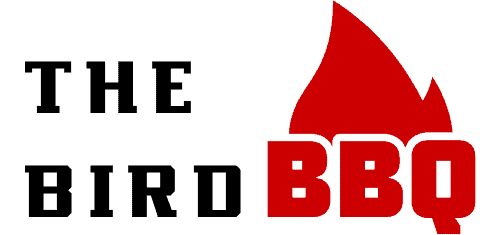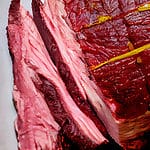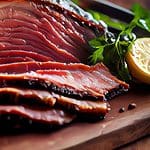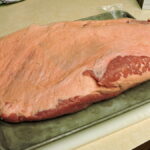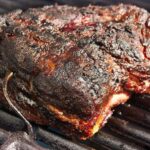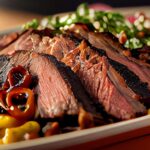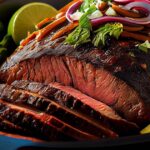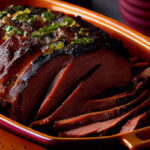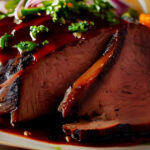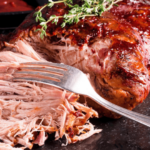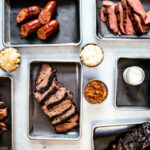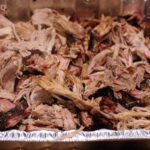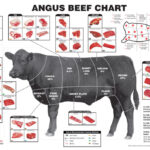How Much Brisket to Feed 50 People: A Chef’s Guide
As a chef, one of the most common questions I get asked is “how much brisket should I serve for a group of 50 people?” It’s a great question and one that requires some careful consideration. After all, nobody wants to run out of food at a dinner party or event, but at the same time, nobody wants to be stuck with a ton of leftovers either.
In this article, we’ll go over the various factors you should consider when determining how much brisket to feed 50 people, as well as some tips for measuring, cooking, and serving this delicious cut of meat.
Determining the Right Amount of Brisket for Your Event
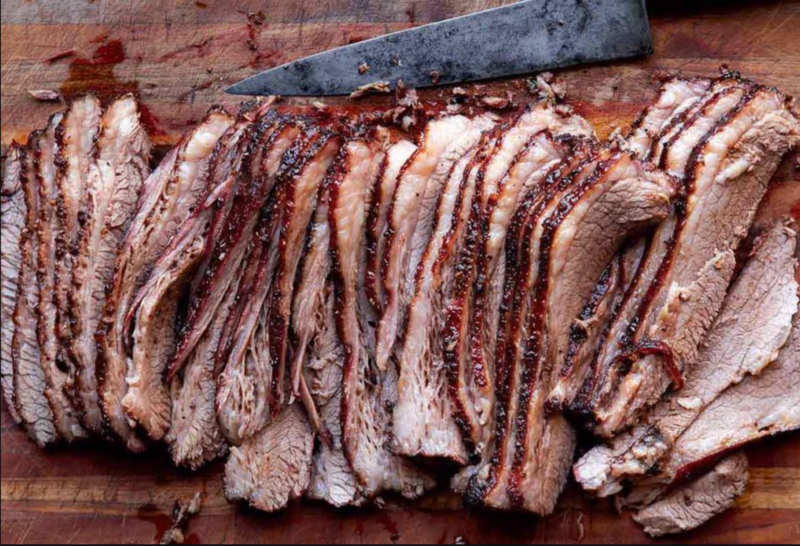
The first step in determining how much brisket to serve is to consider the type of event you’re having. Is it a formal dinner party, a casual barbecue, or something in between? The formality of the event will determine the number of side dishes and appetizers you’ll need, as well as the portion size of the main course.
Next, think about the size of your guest list. Do you have a lot of big eaters or a more diverse group with some lighter eaters? If you have a lot of big eaters, you’ll need to account for that when determining the amount of brisket you need.
It’s also a good idea to consider any dietary restrictions or allergies your guests may have. For example, if you have a few vegetarians in the group, you’ll need to make sure you have enough non-meat options to satisfy them.
As a general rule of thumb, it’s a good idea to plan for about half a pound of brisket per person. This will give you a rough estimate of the amount of meat you’ll need, but it’s always better to err on the safe side and have a little bit extra. After all, leftover brisket can always be used for sandwiches or other recipes later on.
Measuring the Amount of Brisket Needed
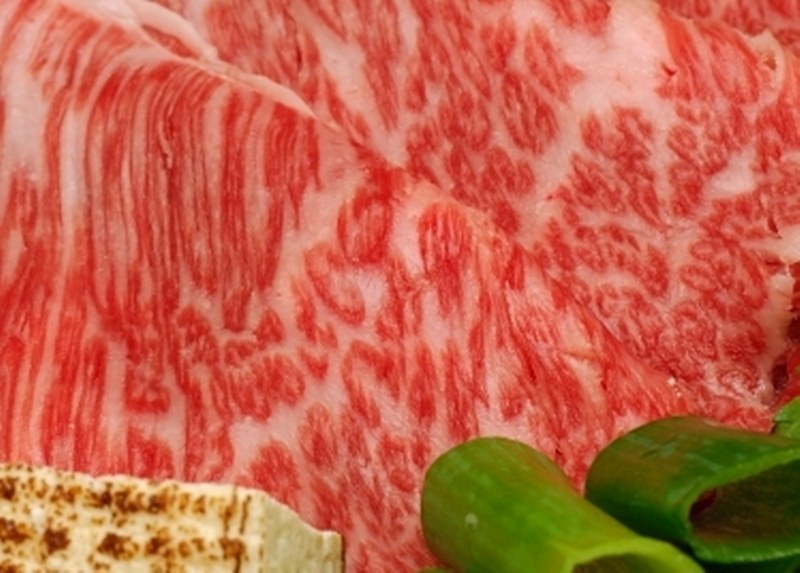
Once you have a rough estimate of the amount of brisket you’ll need, the next step is to measure it out. A good way to do this is to weigh the raw brisket on a kitchen scale. One pound of raw brisket will typically yield about half a pound of cooked meat, so if you need 25 pounds of cooked brisket, you’ll need to start with 50 pounds of raw brisket.
It’s important to note that the weight of the raw brisket will also include the fat and bone, so the finished product will be a bit lighter. As a result, it’s always a good idea to have a little bit extra on hand in case you don’t get the yield you were expecting.
Techniques for Cooking Brisket
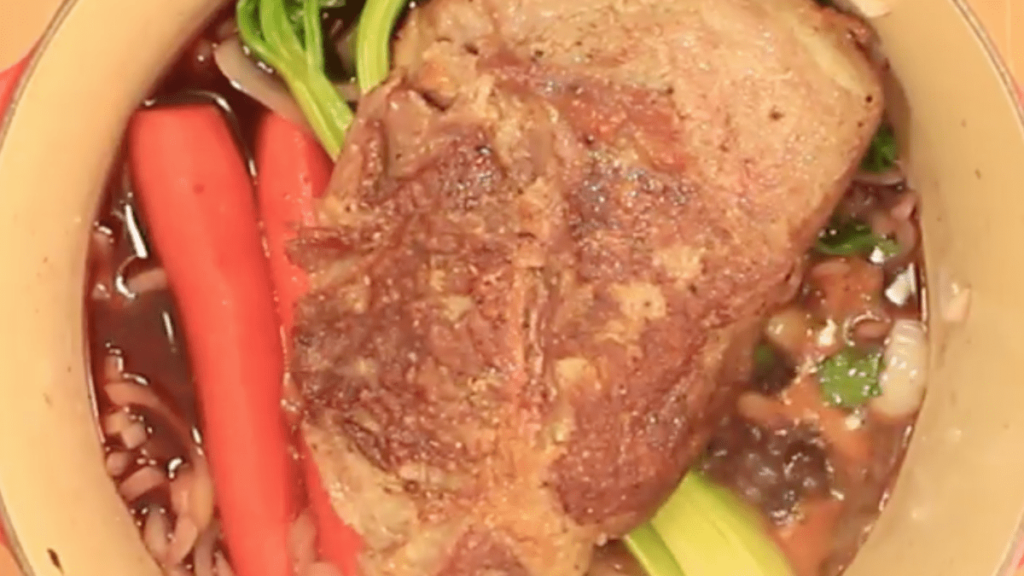
There are a few different techniques you can use to cook brisket, including a dutch oven, a slow cooker, or a low temperature oven. Each method has its own advantages and disadvantages, so it’s important to choose the one that’s right for your needs.
For example, a dutch oven is a great choice if you want to cook the brisket on the stovetop. It allows you to sear the meat and create a delicious crust, and the heavy pot will hold in the heat and moisture, resulting in a tender and flavorful brisket.
On the other hand, a slow cooker is a great option if you want to set it and forget it. Simply place the raw brisket in the slow cooker with your choice of seasonings and let it cook on low heat for a long time. The low and slow cooking process allows the meat to become tender and flavorful, and the fat will melt away, leaving you with a moist and delicious brisket.
If you don’t have a dutch oven or slow cooker, you can also use a low temperature oven to cook your brisket. Simply place the meat in a roasting pan and bake it at a low temperature for several hours until it’s tender and cooked through.
Brisket Yield: Factors That May Affect the Amount of Cooked Meat
There are a few factors that can affect the yield of cooked brisket, including the cooking method, the type of meat you’re using, and the amount of fat on the meat.
For example, if you’re using a slow cooking method like a dutch oven or slow cooker, you may get a higher yield of cooked meat because the low and slow cooking process allows the fat to melt away, resulting in a leaner and more flavorful brisket.
On the other hand, if you’re using a tougher cut of meat like a whole packer brisket, you may get a lower yield of cooked meat because the meat may be more difficult to slice and may contain more fat.
It’s also important to consider the amount of fat on the meat, as this can affect the yield of cooked brisket. A brisket with a higher fat content may yield a lower amount of cooked meat once the fat has melted away, while a leaner cut of meat may yield a higher amount of cooked meat.
Brisket Recipes: Delicious Ways to Enjoy This Delicious Cut of Meat
Brisket is a delicious and versatile cut of meat that can be used in a variety of recipes. Whether you’re looking for a classic brisket recipe or something a little more creative, there are plenty of options to choose from.
One classic way to enjoy brisket is to slow cook it in a dutch oven or slow cooker with your choice of seasonings and vegetables. This method results in a tender and flavorful brisket that’s perfect for a family dinner or a big crowd.
Another great option is to use leftover brisket in sandwiches, tacos, or burritos. Simply slice or shred the brisket and mix it with your favorite seasonings and serve it with your choice of bread, tortillas, or other wraps.
If you’re feeling creative, you can also use brisket in a variety of other recipes, such as soups, stir-fries, or pasta dishes. Simply shred the meat and add it to your favorite recipe for a quick and easy meal.
No matter how you choose to enjoy your brisket, it’s sure to be a hit with your friends and family.
Brisket Cuts: Choosing the Right Cut for Your Needs
When it comes to choosing the right cut of brisket, there are a few things to consider. The first thing to consider is the size of your guest list and the amount of meat you’ll need. A whole brisket is a good choice for a large crowd, while a flat cut or packer cut may be more suitable for a smaller group.
It’s also important to consider the type of meat you want to use. A flat cut is generally leaner and easier to slice, while a packer cut is a tougher and more flavorful cut of meat. If you’re unsure which cut to choose, a good rule of thumb is to go with a half pound of meat per person.
Another thing to consider is the amount of fat on the meat. A brisket with a higher fat content will be more flavorful and tender, but it may also have a lower yield once it’s cooked. If you’re trying to cut back on fat, a leaner cut of meat may be a better choice.
No matter which cut of brisket you choose, it’s sure to be a delicious and satisfying meal for your guests.
Other Considerations When Planning a Meal with Brisket
In addition to the main course, it’s also important to consider the side dishes and appetizers you’ll be serving with your brisket. Some great options to consider include potato salad, coleslaw, baked beans, and a variety of vegetables.
If you’re serving a large group, it’s also a good idea to have some extra brisket on hand in case someone wants seconds. Leftover brisket can also be used for sandwiches or other recipes, so it’s always a good thing to have a little bit extra.
Brisket Cuts and Their Characteristics
There are a few different cuts of brisket to choose from, each with its own characteristics and flavors. A flat-cut brisket is a great choice for slow cooking and is generally easier to slice. On the other hand, a whole packer brisket is a tougher cut of meat that requires longer cooking times, but it can be more flavorful and tender once it’s cooked through.
Factors That May Affect the Amount of Brisket Needed
There are a few other factors that may affect the amount of brisket you need to serve 50 people. For example, if you’re cooking for a large group, you may need to account for the fact that some people may want larger portions.
Additionally, if you’re serving the brisket at a football game or other sporting event, you may need to account for the fact that people tend to eat more when they’re watching a game.
Factors That May Affect the Yield of Cooked Brisket
There are a few factors that may affect the yield of cooked brisket, including the cooking process, the type of meat you’re using, and the amount of fat on the meat.
For example, if you’re using a tough cut of meat, it may require longer cooking times and result in a lower yield. On the other hand, if you’re using a leaner cut of meat, it may have a higher yield.
It’s also important to consider the amount of fat on the meat, as this will melt away during the cooking process and affect the final yield.
Chef’s Tips for Preparing and Serving Brisket
There are a few tips to keep in mind when preparing and serving brisket to a large group. First and foremost, it’s important to choose a great recipe that will ensure the meat is tender and flavorful. Slow cooking is generally the best way to achieve this, as it allows the meat to become tender and flavorful over a longer period of time.
When serving the brisket, be sure to slice it against the grain for the most tender and flavorful results. If you have leftover brisket, it’s a great choice for sandwiches or other recipes.
Tips for Choosing the Right Cut of Brisket
When it comes to choosing the right cut of brisket, there are a few things to consider. The first thing to consider is the size of your guest list and the amount of meat you’ll need. A whole brisket is a good choice for a large crowd, while a flat cut or packer cut may be more suitable for a smaller group.
It’s also important to consider the type of meat you want to use. A flat cut is generally leaner and easier to slice, while a packer cut is a tougher and more flavorful cut of meat. If you’re unsure which cut to choose, a good rule of thumb is to go with a half pound of meat per person.
Another thing to consider is the amount of fat on the meat. A brisket with a higher fat content will be more flavorful and tender, but it may also have a lower yield once it’s cooked. If you’re trying to cut back on fat, a leaner cut of meat may be a better choice.
Ideas for Using Leftover Brisket
If you end up with leftover brisket, there are plenty of delicious ways to use it up. One of the most popular options is to make brisket sandwiches, which are great for lunch or a quick dinner. Simply slice the leftover brisket and pile it on top of your favorite bread with some mustard, mayo, and your choice of vegetables.
Another great option is to use the leftover brisket in tacos or burritos. Simply shred the meat and mix it with your favorite taco seasoning, then serve it with some tortillas, cheese, and your choice of toppings.
You can also use leftover brisket in a variety of other recipes, such as pasta dishes, stir-fries, or soups. Simply shred the meat and add it to your favorite recipe for a quick and easy meal.
How to Store and Reheat Leftover Brisket
If you have leftover brisket and you’re not sure how to store it, there are a few simple steps you can follow to keep it fresh. First, wrap the brisket tightly in plastic wrap and place it in an airtight container. This will help to prevent it from drying out or getting contaminated by other foods in the refrigerator.
To store the leftover brisket in the freezer, wrap it tightly in plastic wrap and then place it in a freezer-safe bag or container. It should last for about 3-4 months in the freezer.
When you’re ready to reheat the leftover brisket, there are a few different methods you can use. One option is to place it in a baking dish and reheat it in the oven at 350 degrees until it’s hot and tender. You can also slice the brisket and reheat it on the stovetop in a pan with a little bit of oil or broth.
No matter how you choose to store or reheat your leftover brisket, it’s important to make sure it’s heated through and that it reaches a safe internal temperature of at least 145 degrees Fahrenheit. This will help to ensure that the meat is fully cooked and safe to eat.
Tips for Storing and Using Leftover Brisket
If you end up with leftover brisket, it’s a good idea to store it in the refrigerator or freezer until you’re ready to use it. To store in the refrigerator, simply wrap the brisket tightly in plastic wrap and store it in an airtight container. It should last for abouta week in the refrigerator.
If you want to store the brisket for a longer period of time, you can also freeze it. To do this, wrap the brisket tightly in plastic wrap and then place it in a freezer-safe bag or container. It should last for about 3-4 months in the freezer.
When you’re ready to use the leftover brisket, simply thaw it in the refrigerator or microwave and then reheat it in the oven or on the stovetop. It’s a great choice for sandwiches, tacos, or other recipes, and it’s always a good thing to have a little bit extra on hand.
In conclusion, determining how much brisket to feed 50 people requires careful consideration of a variety of factors, including the type of event, the size of your guest list, and any dietary restrictions or allergies. By following these tips and considering the factors outlined in this article, you’ll be well on your way to serving a delicious and satisfying meal to your guests.
More Brisket and BBQ Party Resource
Butcher’s Prime Brisket Injection Recipe
Cost of Deliciousness: How Much is Brisket and Why is it Worth it
Easy Masterbuilt Smoked Brisket Recipe for Tender, Juicy Success
How Long To Cook A 15 lb Brisket: Right Timing For Tender & Delicious Results
Perfect Cook Time for Smoking a 2-Pound Brisket
Cooking the Perfect Pit Boss Brisket Recipe (with 3 Smokers)
Delicious Traeger Brisket Recipe to Elevate Your BBQ Game
Franklin BBQ Brisket Recipe: The Best Brisket You’ll Ever Taste
Brisket Flat Recipe: A Step-by-Step Guide to Tender, Juicy Bliss
How Long Can You Keep Pulled Pork Fresh? Expert Tips and Tricks
BBQ Party: How Much BBQ to Feed 100 Guests? (Precise Calculation)
Ultimate Guide to Throwing a Large BBQ Party: Tips, Tricks, and Ideas
How Much Pulled Pork for 40 People (Easy Guide)
How Many Steaks In A Cow? Let’s Count!

Shara @The Bird BBQ
Shara loves to experiment with different flavors and techniques when it comes to BBQ. She has been perfecting her craft for years and loves hosting backyard BBQs with friends & family. She often comes up with creative recipes that her guests rave about.
